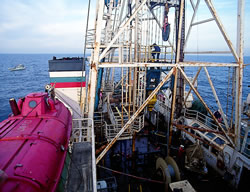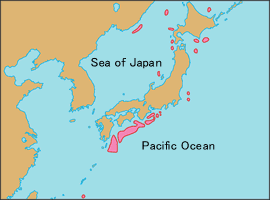|
Special Feature*
Methane Hydrate, a Future Energy Source Hidden Deep Under the Ocean Floor
Methane hydrate is coming into the spotlight as a possible source of energy for future generations. Geologists estimate there is enough methane hydrate lying hidden under
the sea floor around Japan to provide the equivalent of a 100-year supply of natural gas for the country. Today, Japan must import most of its energy resources—could methane hydrate change that?
Written by Takahashi Koki, Photos by Sakai Nobuhiko
Other photo/illustration collaboration: Japan National Oil Corporation

Prospecting for methane hydrate about 100 km off Omaezaki Cape in Shizuoka Prefecture, autumn 1997. The ocean here is about 200 meters deep.
|
Natural gas pipelines carrying a mixture of gas and water have been known to block up, stopping the gas flow. This happens when methane molecules in the natural gas are trapped by frozen water molecules, making a white, ice-like substance that builds up and plugs the pipe. The substance is methane hydrate, a kind of "flammable ice."
Methane hydrate is a crystalline substance like ice, composed of molecules of water and methane. It is stable under low temperatures and high pressure, and is found mainly below permafrost and in geological formations under the ocean depths. If we can extract the methane, we can use it to replace fuels like oil and coal. In the 1970s, scientists around the world began looking into the potential of methane hydrate as a new source of energy.
Sonar surveys indicate that there could be about 7 trillion cubic meters of methane hydrate under the sea around Japan. This is equivalent to a 100-year supply of natural gas for the country. Since about 80% of Japan's energy sources come from abroad, it would clearly be desirable to use this type of energy.
Between 1995 and 2000, basic research was done while searching for methane hydrate in the Nankai Trough off the Pacific Ocean coast, between the Kii Peninsula and Shikoku. The Nankai Trough is an ocean trench paralleling part of the Japanese archipelago. Some methane hydrate was discovered and extracted, reinforcing hopes for future energy supplies and encouraging the Ministry of Economy, Trade and Industry to draw up a 16-year plan called the Methane Hydrate Exploitation Program. The program promotes work in the field from 2001 to 2016 and includes these goals:
· |
To identify effective ways to explore for methane hydrate resources, which are said to lie under the sea bed at depths of 800 to 3,000 meters; |
· |
To determine where and how these resources can be recovered; |
· |
To determine whether extraction and consumption could harm the environment; and |
· |
To verify research results while exploring, drilling test wells and conducting production tests. |
Test wells will be drilled at about a dozen sites off the shores of Japan, starting in 2004.
The estimated amount of reserves is enormous, encouraging hope for the future. But questions remain—how much of the estimated 7 trillion cubic meters of methane hydrate off Japan can be recovered, and how much of this can be recovered economically? The program will go nowhere if it is technically impossible to recover more than a tiny fraction of the reserves, or if it costs more to extract and transport methane hydrate than what is paid for oil and natural gas. The potential for global warming must also be addressed—methane hydrate is a relatively clean fuel because it does not emit sulphur oxides when burned, but methane is a greenhouse gas, so we cannot let it escape into the atmosphere.
"Flammable ice" lies hidden under the ocean depths. Researchers continue to search for ways to recover it and use it as a fuel. 
Methane hydrate reserves off the shores of Japan |
|
Possible extraction method |
 |
|

|
|
The pink section indicates a layer said to hold methane hydrate reserves.
|
|
The drilling vessel on the ocean surface sends a drill pipe straight down. The bit on the end of the spinning drill digs through the ocean floor into the methane hydrate layer.
|
|